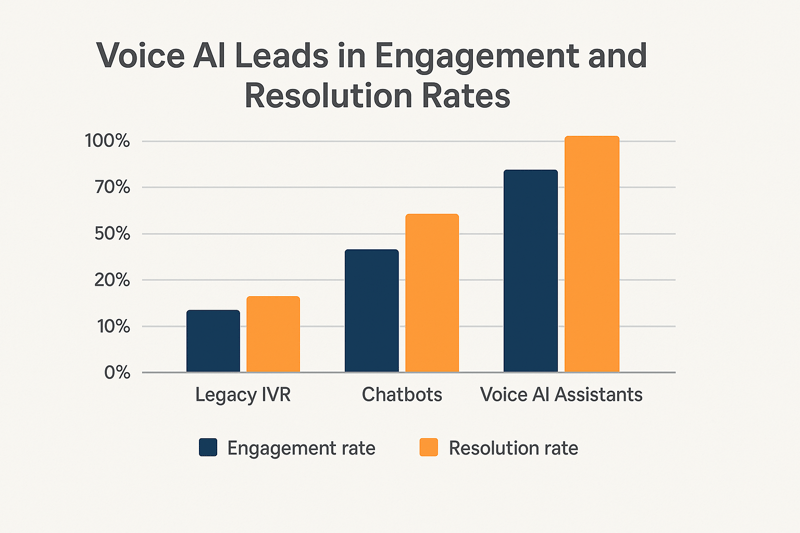Streamlining workflows and optimizing team efficiency.
Voice AI for the Operations Manager

Addressing Operations Manager Pain Points with Voice and Conversational AI:
-
Basic Call Handling Straining Resources:
-
Voice AI & Conversational AI can automate routine call handling tasks, such as providing FAQs, account information, and troubleshooting steps, freeing up live agents for more complex cases. This reduces the load on the team and allows resources to be directed toward higher-value work.
-
AI-powered self-service options (e.g., interactive voice response systems or chatbots) can handle standard queries efficiently, improving operational flow.
-
-
Missing Customer Calls During Peak Hours:
-
Conversational AI can ensure that customers never have to be left waiting. AI-powered systems can manage high call volumes, triage inquiries, and route them to the appropriate department or agent. During peak times, AI can manage an initial layer of engagement, ensuring that urgent cases are flagged for priority handling.
-
Voice AI systems can also be integrated with scheduling systems to predict peak hours and help allocate agents accordingly, ensuring call coverage.
-
-
Call Volume Slowing Everything Else Down:
-
AI solutions can provide detailed reporting and insights into call patterns, helping operations managers understand trends, predict peak times, and optimize staffing levels.
-
By automating routine inquiries, Voice AI minimizes the impact of call volume on other workflows, allowing teams to focus on higher-priority tasks and increasing overall operational efficiency.
-
Solution Framework for the Pillar Page:
-
Why These Challenges Matter: Establish the connection between high call volumes and their impact on efficiency, employee workload, and customer experience.
-
How AI Enables a Change: Highlight the specific features of Voice and Conversational AI that can resolve these issues—automation, seamless integration, scalability, and 24/7 availability.
-
Success Stories/Use Cases: Show real-world examples where AI has successfully reduced call handling time, decreased missed calls, and improved operational speed.
The key is presenting Voice and Conversational AI not just as tools, but as enablers of efficiency and growth. AI can be positioned as a strategic partner that supports operations teams rather than just a technology to implement. The focus should be on ease of adoption, measurable outcomes (like faster resolution times, improved agent productivity), and minimizing disruption during transition.
How Voice AI Addresses and how it can help:
🔁 Manual Call Routing Consumes Resources
- Voice AI introduces the idea of intelligent call triage—automatically routing inbound calls based on intent.

- A visual workflow diagram of how calls are categorized, escalated, or resolved without a human touch helps an Ops Manager understand however the below table explains how the advancement in technology help deliver better results (lola improve graphic)
.jpeg?width=704&height=484&name=Image%2031-03-2025%20at%2011.24%20(1).jpeg)
Download the advancements in Speech to Speech AI and why they outperform Chatbots and IVR (erin pdf)
6 Reasons Why Speech-to-Speech AI Beats IVR / Chatbots
-
Natural, Conversational Interactions:
-
Speech-to-speech AI can engage in natural conversations, unlike legacy IVR systems, which typically rely on rigid, menu-based interactions. This creates a more seamless user experience, where customers can speak naturally without being limited by pre-defined options.
-
-
Real-Time Understanding and Response:
-
Legacy IVR systems often struggle with understanding complex speech patterns, slang, or interruptions. Speech-to-speech AI continuously processes and understands real-time speech, allowing for faster and more accurate responses without requiring users to repeat themselves or follow strict commands.
-
-
Context Awareness:
-
Speech-to-speech AI can track context throughout the conversation and remember previous interactions, making the experience more personalised. Legacy systems often fail at this, requiring users to start over or provide repetitive information at different stages.
-
-
Advanced NLP and Machine Learning:
-
Unlike traditional chatbots or IVRs that rely on pre-set rules or keyword-based recognition, speech-to-speech AI uses advanced Natural Language Processing (NLP) and machine learning to understand intent, manage ambiguity, and provide more intelligent responses.
-
-
Scalability and Multi-Channel Support:
-
Speech-to-speech AI can scale much more easily and efficiently, handling hundreds or thousands of simultaneous conversations across voice, phone, and chat channels. Legacy systems often require additional infrastructure for high volumes and can become overwhelmed, especially during peak times.
-
-
Increased Accuracy and Fewer Errors:
-
With continual improvements in voice recognition and AI training, speech-to-speech AI is far more accurate than traditional IVR systems or chatbots. The sophisticated algorithms understand accents, dialects, and complex sentence structures, leading to fewer miscommunications and errors during interactions.
-
-
Foundation Models for Voice (Multimodal LLMs):
-
New foundation models such as Whisper, Meta’s MMS, Google’s Gemini, OpenAI’s GPT-4 Turbo + Voice, and Speech-to-Speech Transformers are driving a significant shift in the field of voice AI. These models are capable of understanding and generating natural speech—effectively allowing AI to engage in real-time, human-like conversations.
-
-
Unified Pipeline for Voice AI:
-
These multimodal large language models (LLMs) combine the capabilities of speech recognition, NLU, response generation, and speech synthesis in one seamless process. This integration reduces delays and maintains the nuance of conversations, allowing AI to respond quickly and in a way that feels natural.
-
-
Reducing Latency and Preserving Nuance:
-
The ability to process multiple stages of communication in a single pipeline is revolutionary because it reduces lag and keeps the context intact across interactions. This makes conversations with AI feel more fluid, real-time, and human-like, as it can better understand and react to subtleties in tone, emotion, and intent.
-
This is a big deal because legacy systems often operate in isolated stages—speech recognition here, followed by separate NLU and response generation processes. Each stage introduces potential delays, errors, or loss of context. Multimodal LLMs, by combining all these functions into a unified system, make voice interactions much more efficient and capable.
🗣️ 2. Real-Time, Natural Speech Recognition (ASR)
-
Advances in Automatic Speech Recognition (ASR) (e.g., Whisper by OpenAI) enable near-human transcription accuracy across accents, noisy environments, and even domain-specific jargon.
-
ASR is now fast and accurate enough to power real-time, turn-by-turn voice conversations, not just commands.
🧬 3. Semantic Intent Recognition (NLU)
-
Transformers and LLMs now understand messy, ambiguous, and multi-intent inputs better than any previous intent classifiers.
-
They go beyond keyword matching to infer context, emotion, urgency, and intent across multiple turns—something IVRs and early chatbots could not do.
🔁 4. Natural Interruptibility + Turn-Taking
-
Unlike legacy IVRs or rule-based bots, voice AI can now handle barge-ins, overlapping speech, and emotional cues.
-
This makes the experience feel fluid, human-like, and not like navigating a rigid menu.
🔊 5. High-Fidelity Neural TTS (Text-to-Speech)
-
New neural TTS models (e.g., OpenAI’s voice models, Microsoft’s VALL-E) produce hyper-realistic, expressive voices.
-
These voices can match tone, pitch, and pacing to the user, improving trust and engagement.
🔄 6. Low-Latency Speech-to-Speech Systems
-
Emerging architectures (like direct speech-to-speech transformers) eliminate the need for separate STT → NLP → TTS steps.
-
This reduces round-trip time from 2–5 seconds (legacy) to <500ms, enabling natural back-and-forth.
🔐 7. Edge AI and On-Device Processing
-
Voice agents can now run locally or in hybrid cloud, improving privacy, latency, and reliability—ideal for industries like finance or healthcare.
After All Low engagement and Resolution and Missed calls is lost business.
📞 Missed Calls = Lost Business
Which is why:
-
The concept of 24/7 virtual agents that never miss a call becomes highly attractive.
-
Early messaging can highlight real-world stats, e.g., “Companies using Voice AI recovered 30% of missed sales calls through intelligent follow-ups.”
🔄 Processes Bottlenecked by Call Volume
-
Here we show how Voice AI scales with demand, absorbing peak call loads and freeing up human agents for high-value tasks.
Voice AI scales with demand by leveraging cloud-based, elastic infrastructure and parallel processing, which allows it to handle virtually unlimited concurrent calls—unlike traditional systems limited by physical agents or IVR line capacity.
📞 Why Traditional Voice Systems Bottleneck
Limitation
Legacy Call Centers / IVR
Agent capacity
Limited to # of human agents
IVR line capacity
Fixed, based on telco infrastructure
Peak demand management
Requires overstaffing or long queues
Call overflow
Leads to dropped calls or hold times
How Voice AI Avoids These Bottlenecks
✅ 1. Parallel Conversations at Scale
Voice AI can handle hundreds or thousands of calls simultaneously, because each voice agent runs as a cloud-based process—not a person or physical line.
Example: 1,000 users can call at once and speak to 1,000 AI agents—no hold queue needed.
🚀 2. Instant Elastic Scaling
AI-powered contact systems (like SimplyAI or Twilio Voice + LLMs) scale on demand:
-
During spikes (e.g., Black Friday, outage, new campaign), AI instances spin up automatically.
🔁 Real-World Analogy
Traditional call centers are like airport check-in desks—you only get help when an agent is free.
Voice AI is like self-check-in kiosks that scale instantly when the queue grows. -
-
A before-and-after workflow map comparing average response times or ticket resolution speeds helps quantify the opportunity.
(Ewan Ops Video Here)
“Imagine if your team never had to manually transfer a call again.”
See these simple business Impact Case Studies that achieve:
-
320% increase in Leads Generated
-
99% increase in response times
-
Hours of admin volume swallowed up
By Voice AI agents that do not sleep, go ill, take holidays, take a weekend off.
The Key Question:
“Could automating routine voice tasks free up teams for more? "
How Voice AI Solves Workflow Inefficiencies
“From Workflow Bottlenecks to Workflow Automation: How Voice AI Unblocks Operations”
“Could automating routine voice tasks free up teams for more strategic work?”
— Operations Manager, SimplyAI Customer
The simple answer is if beautician, solicitors, plumbers and garages are you can!
Supporting content
How Voice AI Solves Workflow Inefficiencies
“From Workflow Bottlenecks to Workflow Automation: How Voice AI Unblocks Operations”
“Could automating routine voice tasks free up teams for more strategic work?”
— Operations Manager, SimplyAI Customer

The simple answer is if beautician, solicitors, plumbers and garages are you can!
Supporting content
Operations Manager Consideration-Stage Evaluation: How Voice AI Delivers
✅ Key Evaluation Criteria & How Voice AI Measures Up
1. Workflow Automation Features
What they’re looking for: Seamless automation that reduces manual tasks, improves efficiency, and frees up agent time.
Voice AI in action:
-
Auto-scheduling: Instantly books appointments or callbacks based on real-time availability.
-
Order tracking automation: Handles repetitive inbound/outbound calls for order status updates without human intervention.
-
Escalation routing: Detects urgency and reroutes complex cases to live agents with context.
-
Pre-call & post-call task automation: Automatically updates CRM and task management systems.
Chapter IV
Voice AI for Operations Leaders
Streamline Your Ops with Scalable Voice AI Automation
Reduce manual tasks, gain real-time insights, and elevate efficiency—all with zero disruption to your operations.
Voice AI helps Operations Managers automate workflows, accelerate resolution times, and integrate seamlessly with existing systems. Built for scale. Designed for simplicity.
✅ Why Ops Teams Love Voice AI
|
🔍 What You Need |
💡 What Voice AI Delivers |
|---|---|
|
Workflow automation |
Auto-scheduling, order tracking, real-time escalations |
|
Operational visibility |
Advanced reporting, real-time analytics, actionable insights |
|
Seamless integration |
No-code/low-code setup, connects with existing tools |
|
Scalability & flexibility |
Works across IVR, outbound calls, WhatsApp voice & more |
See It in Action
Book a walkthrough to discover how Voice AI helps you.
Supporting content
Voice AI for Operations Leaders
Streamline Your Ops with Scalable Voice AI Automation
Reduce manual tasks, gain real-time insights, and elevate efficiency—all with zero disruption to your operations.
Voice AI helps Operations Managers automate workflows, accelerate resolution times, and integrate seamlessly with existing systems. Built for scale. Designed for simplicity.
✅ Why Ops Teams Love Voice AI
| 🔍 What You Need | 💡 What Voice AI Delivers |
|---|---|
| Workflow automation | Auto-scheduling, order tracking, real-time escalations |
| Operational visibility | Advanced reporting, real-time analytics, actionable insights |
| Seamless integration | No-code/low-code setup, connects with existing tools |
| Scalability & flexibility | Works across IVR, outbound calls, WhatsApp voice & more |
📊 Purpose-Built for Operational Efficiency
Automate the Repetitive. Empower the Critical.
Let Voice AI handle:
- Appointment booking & reminders
- Order & delivery status updates
- Task creation in Asana, Trello, or your CRM
- Field service follow-ups
- After-hours customer support
All while giving you analytics that drive improvement.
❗ Common Concerns? Handled.
🚧 “Will it disrupt our current workflows?”
Not at all. Voice AI integrates smoothly with what you already use. Start small, scale fast—with zero downtime.
📈 “Can it scale with us?”
Absolutely. Whether you're handling 100 or 100,000+ calls, Voice AI adapts to your team size, locations, and evolving workflows—seamlessly.
See It in Action
Book a walkthrough to discover how Voice AI helps you:
Supporting content
Conclusions
Potential Concern: Will this disrupt current workflows or require major process overhauls?
✅ How to Address:
-
Visual workflow integration: Provide diagrams or step-by-step documentation showing exactly how Voice AI integrates with IVR, CRM, ticketing, and other systems—ensuring a smooth transition.
-
Dedicated onboarding & support: Highlight onboarding specialists or solution architects who guide teams through setup, ensuring minimal disruption and fast adoption.
-
Industry-specific playbooks: Offer pre-built workflows tailored to different industries (e.g., appointment scheduling for healthcare, delivery updates for logistics)—so teams can start seeing value immediately.:
From Our Blog
Stay up to date with what is new in our industry, learn more about the upcoming products and events.
Meta Begins Training its AI Tools on EU User Data

Meta Software Issue: How It Affects Your Quest Headset




